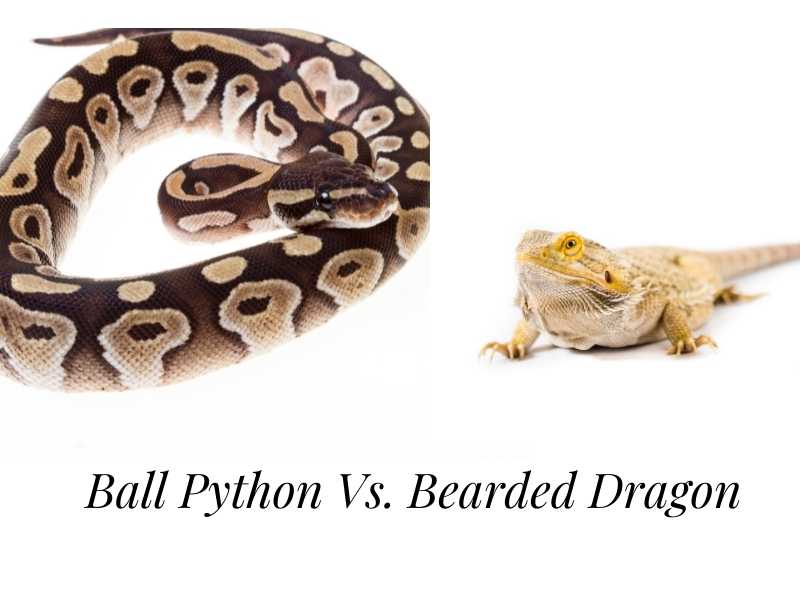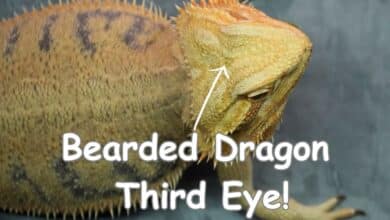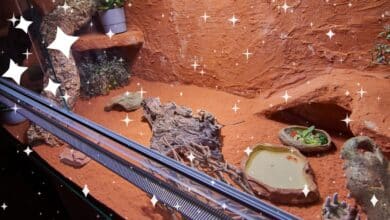Bearded Dragon vs Ball Python: Which Is Right For You?

When deciding between a bearded dragon vs ball python, there is a multitude of factors that you’ll want to consider. When it comes down to choosing between a bearded dragon and a ball python, one will need to consider diet, handling requirements, personal preference, and more.
A Bearded Dragon is ideal for pet owners who want a more active reptile that moves around on a regular basis but doesn’t want to deal with feeder mice. Ball Pythons are great for owners who want a low-maintenance pet and who don’t mind feeding mice.
Contents
Basics of Choosing Between a Bearded Dragon and a Ball Python
The main items to consider when trying to choose between a bearded dragon and a ball python include:
- Initial snake or lizard preference
- Experience with reptiles
- Cost to purchase
- Tank setup required
- Amount of care and attention needed
- Type of food
- Cost of food
- Lifespan
Continue reading to learn more about whether a bearded dragon vs a ball python is the right fit for you and your family, both species’ benefits, drawbacks, prices, and more.
What is A Bearded Dragon?
For individuals who are new to reptiles, the sociable Bearded Dragon is an excellent choice. They’re pretty straightforward to look after, and their placid personalities make them easy to manage. They’re also known for their distinct personalities and “grinning” looks.
Overall, Beardies are laid-back lizards that consume a simple diet. While they do, however, have heating and lighting needs, these are simple to provide with a proper setup.
Benefits of Owning a Bearded Dragon
Bearded Dragons Don’t Eat Mice
Bearded Dragons in the wild eat insects, which account for around 35-40% of their diet and include crickets, cockroaches, worms, and even tiny critters like mice. However, mice are not fed to bearded dragons raised as pets. This means you can avoid giving them live or frozen feeder mice and stick to foods that won’t make you feel sick when feeding your reptile.
Bearded Dragons Bond with Their Caretakers
If you’re searching for a laid-back and sociable reptile, the time and work that goes into caring for a bearded dragon are well worth it. Bearded dragons are regarded as one of the greatest reptile pets owing to their friendly demeanor and gentle attitude (once they get used to you). As a result, they usually adjust well to their human caregivers.
For example, once your beardie has adjusted to their new surroundings, they will enjoy your company and are known to even rush to the front of their tank to say hi.
Bearded Dragons Enjoy Being Handled
Bearded dragons are more placid than most other lizard species, hence they usually allow for more handling. However, to reduce the risk of stress in your bearded dragon, avoid handling it for lengthy periods of time when you first get it.
Keep in mind that the younger the bearded dragon is, the more agitated it can become if touched for an extended period of time. Instead, handle them for a limited period of time at first to allow them to gain trust in you.
Bearded Dragons Have Lengthy Lifespans
In captivity, a bearded dragon’s lifetime ranges from 8 to 15 years. This range is determined by a multitude of hereditary characteristics as well as the level of care they receive.
There Are a Wide Array of Bearded Dragons to Choose From
Bearded dragons come in eight different species, four of which are maintained as pets. The most common pet species is the central bearded dragon. However, reptile enthusiasts can also look for fancy bearded dragons that have been deliberately bred to exhibit uncommon colors and patterns, illuminating their tank.
Bearded Dragons Are Known to Be a Quiet Pet
Bearded dragons are excellent pets because they are calm, quiet, and easy to care for. Bearded dragons also do not vocalize, but instead, make mild hissing noises. For example, when the lizard is threatened or scared of something in its enclosure, it will hiss.
Disadvantages of Owning a Bearded Dragon
You’d think that housing such a little animal would be inexpensive. However, while bearded dragon upkeep is not prohibitively expensive, the initial setup cost can be rather high. For example, just buying a basic cage and bedding for your beardie it can cost you anywhere from $200. This does not include the expense of basking rocks, lighting, or other features that will transform the cage into a more natural setting.
The cost of safety is also a consideration. This lizard, unlike other home pets, is extremely vulnerable. As a result, it will have to be guarded against predatory dogs and cats. This means that the initial setup fee includes security elements like cage protection, which ensures that intruders do not come into touch with or disturb your dragon pet’s natural surroundings.
What Is a Ball Python?
The Ball Python is the most widely kept pet python in the world. Ball pythons are timid by nature, but they make excellent captives since they are tiny, typically sociable, easy to care for, and available in a wide variety of colors and patterns. As a result, ball pythons are an excellent pet for both first-time and seasoned reptile keepers.
Breeders also develop fantastic, inventive, never-before-seen patterns and color variants every year, resulting in a steady stream of new enthusiasts for the species.
Benefits of Owning a Ball Python
Ball Pythons Are Easy to Care For
Ball pythons don’t require nearly as much attention and work from their owners as other companions. Feedings, for example, take place every 7-14 days and have no unique nutritional needs. Even excrement cleaning is also minor, occurring just once a week at most. This makes them great for folks who like to travel but still keep a pet at home to return to.
Ball Pythons Require Little to No Exercise
A ball python doesn’t need to be walked, they don’t have fur, and they stick to their cages most of the time. This makes them a great apartment pet or a pet for someone who can’t keep up with a more mainstream pet’s routine.
Ball Pythons Like to Be Handled
While ball pythons aren’t known for being very emotional or “cuddly,” they do tolerate handling well. Some can even like getting out of their tank and exercising when you handle them.
Just remember to keep an eye out for any signs of stress. For example, you may be handling your ball python too much or at the wrong times, leading it to get nervous.
Take note, however, that even though it’s important to handle your ball python on a regular basis, there will be occasions when you must let it alone.
Ball Pythons Make Excellent Family Pets
While snakes have a negative reputation for being hazardous pets, there have been no reported deaths from ball pythons. Nonetheless, you should still be cautious around them, especially when dealing with little children and newborns. But, overall, they make great family pets.
It may come as a surprise that a ball python is one of the simplest snakes to maintain, but it’s true – they make excellent family pets. Not only are their requirements low, but they are also not aggressive, and bites are uncommon.
Disadvantages of Owning a Ball Python
If you have a snake fear, or if people you live with have a snake phobia, keeping snakes as pets is probably not a great idea.
While there is a case to be made that any phobia may be overcome by confronting it, it is preferable to confront your fear of snakes by visiting your local zoo or wildlife education center rather than purchasing a snake as a pet.
Another disadvantage of having a ball python is that these snakes prefer to be fed rats and mice. In fact, they prefer to be served the full “snack” at once rather than in chunks. As a result, owning a snake as a pet may not be a wise investment if you don’t enjoy handling mice or have a “thing” for witnessing rodents being devoured.
What Is the Average Price of a Bearded Dragon?
Depending on its age, a bearded dragon can cost anywhere from $30 to $100. That, however, simply represents the cost of the beardie. You’ll then need an extra $300 to $600 just to cover the price of their enclosure, basic care materials, and an initial vet visit. This puts the average cost of acquiring a bearded dragon is approximately $300 to $700.
Overall, bearded dragons are generally affordable to purchase, however, the price will also depend on a variety of circumstances like the breeder, the lizard’s health, and more.
What Is the Average Price of a Ball Python?
A common ball python will cost between $40 and $200 on average. However, the precise cost varies greatly based on the snake’s morph or color, as well as whatever genes it may possess. Snakes with a lot of genes that are useful in breeding efforts, for example, cost a lot more.
The regular ball python has the species’ usual wild look. These snakes have a brown to yellow coloration with a big “alien head” marking down the side of their bodies. Since they aren’t in high demand, many breeders will sell these snakes for $40-80.
Bearded Dragon vs Ball Python?
A Bearded Dragon is an excellent choice for pet owners who want a more active reptile that moves about frequently but refuse to deal with feeder mice. Ball Pythons, on the other hand, are ideal for people looking for a low-maintenance pet who don’t mind feeding mice.
When deciding between a bearded dragon and a ball python, however, one must consider all the factors including food, handling needs, and personal preference.





